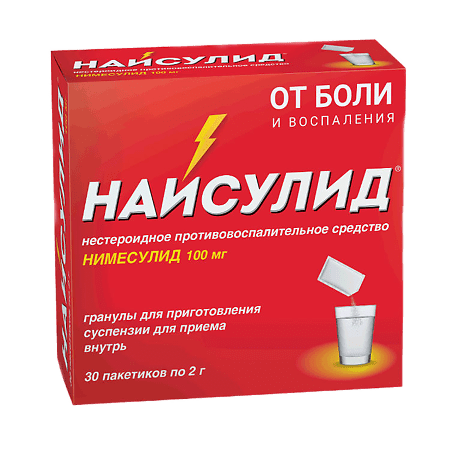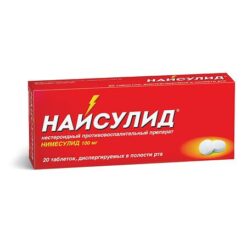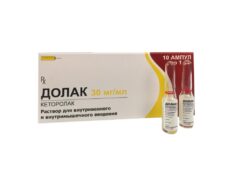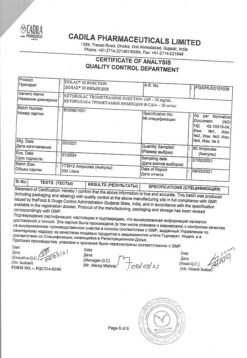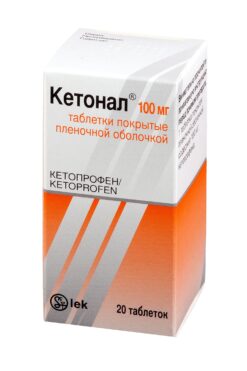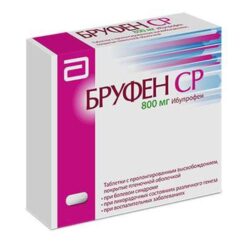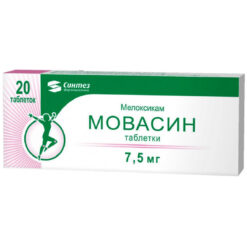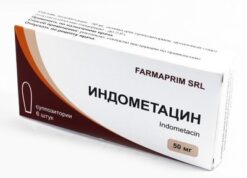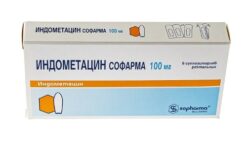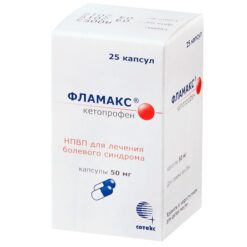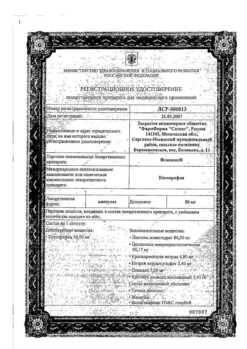No products in the cart.
Naisulide, 100 mg 2 g 30 pcs
€21.87 €18.22
Description
Pharmacotherapeutic group: Non-steroidal anti-inflammatory drug (NSAIDs)
CodeATX: M01AX17
Pharmacological properties.
Indications
Indications
acute pain (pain in the back, lower back; pain syndrome in the musculoskeletal system,
including bruises, sprains and joint dislocations; tendonitis, bursitis; toothache);
symptomatic treatment of osteoarthritis (osteoarthritis) with pain syndrome;
primary algodismenorrhea.
The drug is intended for symptomatic therapy, reducing pain and inflammation at the time of use; nimesulide is recommended for therapy as a second-line drug.
Pharmacological effect
Pharmacological effect
Pharmacotherapeutic group: non-steroidal anti-inflammatory drug (NSAID)
CodeATX: M01AX17
Pharmacological properties
Special instructions
Special instructions
Undesirable side effects can be minimized by using the drug in the minimum effective dose with the minimum duration of use necessary to relieve pain.
There is evidence of very rare cases of serious reactions from the liver, including cases of death, associated with the use of drugs containing drugs. If symptoms similar to signs of liver damage appear (anorexia, itching, yellowing of the skin, nausea, vomiting, abdominal pain, darkening of urine, increased activity of liver transams and nasals), you should immediately stop using the drug Naisulide and consult a doctor. Repeated use of Naisulide in such patients is contraindicated.
Liver reactions, which are in most cases reversible, have been reported with short-term use of the drug.
While using Naisulide, the patient should refrain from taking other analgesics, including NSAIDs (including selective COX-2 inhibitors).
The drug Naisulide should be used with caution in patients with a history of gastrointestinal diseases (ulcerative colitis, Crohn’s disease), since exacerbation of these diseases is possible.
The risk of gastrointestinal bleeding, peptic ulcer/perforation of the stomach or duodenum increases in patients with a history of gastrointestinal ulceration (ulcerative colitis, Crohn’s disease), as well as in elderly patients, with increasing doses of NSAIDs, so treatment should begin with the lowest possible dose. In such patients, as well as in patients who require the simultaneous use of low doses of acetylsalicylic acid or other drugs that increase the risk of complications from the gastrointestinal tract, it is recommended to additionally prescribe gastroprotectors (misoprostol or proton pump blockers).
Patients with a history of gastrointestinal disease, especially older patients, should report new gastrointestinal symptoms (especially symptoms that may indicate possible gastrointestinal bleeding) to their physician.
Naisulide should be administered with caution to patients taking drugs that increase the risk of ulceration or bleeding (oral
corticosteroids, anticoagulants such as warfarin, selective serotonin reuptake inhibitors or antiplatelet agents such as acetylsalicylic acid).
If gastrointestinal bleeding or ulcerative lesions of the gastrointestinal tract occur in patients taking Naisulide, treatment with the drug must be discontinued.
Given reports of visual impairment in patients taking other NSAIDs, if any visual impairment occurs, use of Naisulide should be immediately discontinued and an ophthalmological examination performed.
The drug may cause fluid retention, therefore, in patients with arterial hypertension, renal and/or heart failure, Naisulide should be used with extreme caution. If the condition worsens, treatment with Naisulide should be discontinued.
Clinical studies and epidemiological data suggest that NSAIDs, especially at high doses and with long-term use, may lead to a small risk of myocardial infarction or stroke. There is insufficient data to exclude the risk of such events when using nimesulide. The drug contains sucrose, this should be taken into account by patients suffering from diabetes mellitus (0.15-0.18 XE per 100 mg of the drug) and those on a low-calorie diet. Naisulide is not recommended for use in patients with fructose intolerance, sucrose-isomaltose deficiency, or glucose-galactose malabsorption syndrome. If signs of a “cold” or acute respiratory viral infection occur while using the drug Naisulide, the drug should be discontinued. Nimesulide can change the properties of platelets, so caution must be exercised when using the drug in people with hemorrhagic diathesis, however, the drug does not replace the preventive effect of acetylsalicylic acid in cardiovascular diseases. Elderly patients are especially susceptible to adverse reactions to NSAIDs, including the risk of life-threatening gastrointestinal bleeding and perforation, and decreased renal, liver, and cardiac function. When taking the drug Naisulide for this category of patients, proper clinical monitoring is necessary.
There is evidence of rare cases of skin reactions (such as exfoliative dermatitis, Stevens-Johnson syndrome, toxic epidermal necrolysis) when taking NSAIDs, including nimesulide. At the first manifestations of a skin rash, damage to the mucous membranes or other signs of an allergic reaction, taking Naisulide should be stopped immediately.
The effect of the drug on the ability to drive vehicles and other mechanisms
The effect of the drug Naisulide on the ability to drive vehicles and machines has not been studied, therefore, during the period of use of the drug Naisulide, caution should be exercised when driving vehicles and engaging in potentially hazardous activities that require increased concentration and speed of psychomotor reactions.
Active ingredient
Active ingredient
Nimesulide
Composition
Composition
1 sachet contains:
active ingredient:
nimesulide 100 mg;
excipients:
sugar (sucrose),
maltodextrin,
cetomacrogol 1,000 (macrogol cetostearyl ether),
anhydrous citric acid,
orange flavoring.
Contraindications
Contraindications
hypersensitivity to nimesulide or other components of the drug;
history of hyperergic reactions (bronchospasm, rhinitis, urticaria) associated with
the use of acetylsalicylic acid or other NSAIDs, including nimesulide;
complete or incomplete combination of bronchial asthma, recurrent polyposis of the nose or near the sinuses with intolerance to acetylsalicylic acid and other NSAIDs (including a history);
history of hepatotoxic reactions to nimesulide;
simultaneous use with other drugs with potential hepatotoxicity (for example, other NSAIDs);
chronic inflammatory bowel diseases (Crohn’s disease, ulcerative colitis) in the acute phase;
period after coronary artery bypass surgery;
febrile syndrome with colds and acute respiratory viral infections;
suspicion of acute surgical pathology;
peptic ulcer of the stomach or duodenum in the acute phase; erosive and ulcerative lesions of the gastrointestinal tract; history of perforation or gastrointestinal bleeding;
a history of cerebrovascular bleeding or other diseases accompanied by increased bleeding;
severe bleeding disorders;
severe heart failure;
severe renal failure (creatine clearance <30 ml/min), confirmed hyperkalemia;
children under 12 years of age;
pregnancy and breastfeeding;
alcoholism, drug addiction;
hereditary fructose intolerance, sucrase-isomaltase deficiency and syndrome
malabsorption of glucose-galactose;
With caution
Arterial hypertension, diabetes mellitus, compensated heart failure, coronary heart disease, cerebrovascular diseases, dyslipidemia/hyperlipidemia, peripheral arterial disease, hemorrhagic diathesis, smoking, creatine clearance and 30-60 ml/min.
History of ulcerative lesions of the gastrointestinal tract; history of infection caused by Helicobacter pylori; old age; long-term previous use of NSAIDs; severe somatic diseases.
Concomitant use with the following drugs: anticoagulants (for example, warfarin), antiplatelet agents (for example, acetylsalicylic acid, clopidogrel), oral glucocorticosteroids (for example, prednisolone), selective serotonin reuptake inhibitors (for example, citalopram, fluoxetine, paroxetine, sertraline).
Side Effects
Side Effects
The frequency is classified according to the recommendations of the World Health Organization, depending on the occurrence of the case: very common ≥), common (≥1/100, <1/10), uncommon (≥1/1000, <1/100), rare (≥1/10000, <1/1000), very rare, including isolated reports
Blood and lymphatic system disorders
Rarely: anemia, eosinophilia, hemorrhage;
Very rare: thrombocytopenia, pancytopenia, thrombocytopenic purpura.
Immune system disorders
Rarely: hypersensitivity reactions;
Very rare: anaphylactoid reactions.
Skin and subcutaneous tissue disorders
Uncommon: itching, skin rash, increased sweating;
Rarely: erythema, dermatitis;
Very rare: urticaria, angioedema, facial edema, erythema multiforme, Stevens-Johnson syndrome, toxic epidermal necrolysis (Lyell’s syndrome).
Nervous system disorders
Uncommon: dizziness;
Very rare: headache, drowsiness, encephalopathy (Reye’s syndrome).
Mental disorder
Rarely: a feeling of fear, nervousness, nightly “nightmare” dreams.
Visual disorders
Rarely: blurred vision;
Very reoko: visual impairment.
Hearing and labyrinth disorders
Very rare: vertigo.
Cardiovascular disorders
Uncommon: increased blood pressure;
Rarely: tachycardia, lability of blood pressure, “flushes” of blood to the skin of the face, palpitations.
Respiratory system disorders
Uncommon: shortness of breath;
Very rare: exacerbation of bronchial asthma, bronchospasm.
Gastrointestinal disorders
Common: diarrhea, nausea, vomiting;
Uncommon: constipation, flatulence, gastritis, gastrointestinal bleeding, ulcer and/or perforation of the stomach or duodenum;
Very rare: abdominal pain, dyspepsia, stomatitis, tarry stools
Disorders of the liver and biliary tract
Often: increased activity of liver enzymes;
Very rare: hepatitis, fulminant hepatitis (including deaths), jaundice, cholestasis.
Renal and urinary tract disorders
Rarely: dysuria, hematuria, urinary retention;
Very rare: renal failure, oliguria, interstitial nephritis.
Disorders of water-electrolyte metabolism
Rarely: hyperkalemia.
Others
Uncommon: peripheral edema;
Rarely: malaise, asthenia;
Very rare: hypothermia.
Interaction
Interaction
Glucocorticosteroids increase the risk of gastrointestinal ulcers or bleeding.
Antithrombotic agents and selective serotonin reuptake inhibitors
(SSRls)* such as fluoxetine, increase the risk of gastrointestinal bleeding.
NSAIDs may enhance the effect of anticoagulants such as warfarin. Due to the increased risk of bleeding, this combination is not recommended and is contraindicated in patients with severe coagulation disorders. If combination therapy cannot be avoided, careful monitoring of blood clotting parameters is necessary.
Diuretics
NSAIDs may reduce the effect of diuretics. In healthy volunteers, nimesulide temporarily reduces the excretion of sodium under the influence of furosemide, to a lesser extent – the excretion of potassium and reduces the diuretic effect itself.
The simultaneous use of nimesulide and furosemide leads to a decrease (by approximately 20%) in the area of the concentration-time curve (AUC) and a decrease in the cumulative excretion of furosemide without changing the renal clearance of furosemide.
The simultaneous use of furosemide and nimesulide requires caution in patients with renal or heart failure.
ACE inhibitors and angiotheisin-II receptor antagonists
NSAIDs may reduce the effect of antihypertensive drugs. In patients with mild to moderate renal failure (creatine clearance by 30-80 ml/min), with simultaneous use of ACE inhibitors, angiotensin II receptor antagonists and agents that suppress the cyclooxygenase system (NSAIDs, antiplatelet agents), further deterioration of renal function and the occurrence of acute renal failure, which is usually reversible, is possible. These interactions should be considered in patients taking nimesulide in combination with ACE inhibitors or angiotensin II receptor antagonists. Therefore, the simultaneous use of these drugs should be used with caution, especially in elderly patients. Patients should remain adequately hydrated and renal function should be closely monitored after concomitant use is initiated.
Mifepristone
Theoretically, it is possible to reduce the effectiveness of mifepristone and prostaglandin analogues when used simultaneously with NSAIDs (including acetylsalicylic acid) due to the antiprostaglandin action of the latter. Limited data indicate that use of an NSAID on the same day as a prostaglandin analogue does not adversely affect the effects of mifepristone or a prostaglandin analogue on cervical dilatation, uterine contractility, or reduce the clinical effectiveness of medical abortion.
There is evidence that NSAIDs reduce the clearance of lithium, which leads to increased plasma lithium concentrations and its toxicity. When using nimesulide in patients undergoing lithium therapy, the concentration of lithium in the blood plasma should be regularly monitored.
No clinically significant interactions were observed with glibenclaide, theophylline, -digostin, cimetidine and antacid drugs (for example, a combination of aluminum and magnesium hydroxides).
Nimesulide inhibits the activity of the CYP2C9 isoenzyme. When drugs that are substrates of this enzyme are used simultaneously with nimesulide, the concentration of the latter in plasma may increase.
When prescribing nimesulide less than 24 hours before or after using methotrexate, caution is required, since in such cases the concentration of methotrexate in the blood plasma and, accordingly, the toxic effects may increase.
Due to the effect on renal prostaglandins. inhibitors of prostaglandin synthetase, such as nimesulide, can increase the nephrotoxicity of cyclosporines.
Overdose
Overdose
Symptoms: apathy, drowsiness, nausea, vomiting, pain in the epigastric region. These symptoms are usually reversible with symptomatic and supportive therapy.
Possible increased blood pressure, gastrointestinal bleeding, acute renal failure, respiratory depression, coma, anaphylactoid reactions.
Treatment: symptomatic and supportive therapy. There is no specific antidote. If the overdose has occurred within the last 4 hours, it is necessary to induce vomiting and. or provide activated charcoal (60 to 100 g per adult) and/or an osmotic laxative. Forced diuresis, hemodialysis, hemoperfusion, and urine alkalization are ineffective due to the high degree of binding of nimesulide to blood plasma proteins (up to 97.5%). It is necessary to monitor the state of kidney and liver function.
Storage conditions
Storage conditions
At a temperature not exceeding 25 °C.
Keep out of the reach of children.
Shelf life
Shelf life
3 years. Do not use after expiration date.
Manufacturer
Manufacturer
Alium JSC, Russia
Additional information
| Shelf life | 3 years. Do not use after the expiration date. |
|---|---|
| Conditions of storage | At a temperature not exceeding 25 ° C. Store out of the reach of children. |
| Manufacturer | Alium JSC, Russia |
| Medication form | granules for preparation of oral suspension |
| Brand | Alium JSC |
Other forms…
Related products
Buy Naisulide, 100 mg 2 g 30 pcs with delivery to USA, UK, Europe and over 120 other countries.

